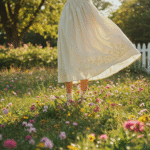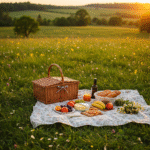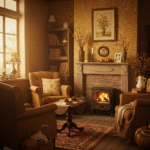Picture this: You wake up to golden sunlight streaming through linen curtains, the smell of fresh bread wafting from your kitchen, and wildflowers nodding gently outside your window. This isn’t just a dream—it’s the cottagecore aesthetic that’s captured hearts everywhere in 2025.
Ready to embrace something that feels like wrapping yourself in Taylor Swift’s “folklore” era and never wanting to leave? I’ll show you how to start living the cottagecore aesthetic today. It works whether you’re in a studio apartment or have rolling acres to call home.
This post contains affiliate links, which means I may earn a small commission if you make a purchase through my links at no extra cost to you. Thank you for supporting my cozy corner of the internet!
What is the Cottagecore Aesthetic?

The cottagecore aesthetic celebrates finding magic in simple, everyday moments. Think Anne of Green Gables meets sustainable living with a dash of Bridgerton charm (but with dirty fingernails and flour-dusted aprons).
You know that feeling when you bite into a tomato straight from the vine? Or when you finish knitting something with your own hands? That’s what the cottagecore aesthetic is all about. The whole philosophy centers around falling head over heels for simple things that make life feel rich and meaningful.
Unlike mystical fairy vibes or witchy aesthetics, the cottagecore aesthetic keeps both feet planted firmly in garden soil. We’re talking about the kind of magic you can touch: fresh-baked scones, hand-sewn quilts, and the pure joy of watching seeds you planted actually grow into something beautiful.
Core Values:
- Slowing down and savoring simple pleasures
- Self-sufficiency and traditional skills over convenience
- Living seasonally and working with nature’s rhythms
- Handmade over store-bought whenever possible
- Building community connections through sharing knowledge and meals
Your Cottagecore Aesthetic Quick-Start Guide
Ready to begin? Here’s your 8-step cottagecore aesthetic starter plan:
- Start a windowsill herb garden – basil, mint, and parsley
- Try making one thing from scratch – bread, jam, or pickles
- Find your local farmers market and buy one seasonal item
- Learn one traditional skill – basic knitting, embroidery, or bread baking
- Create morning and evening rituals – tea time and garden checking
- Start preserving something simple – freeze herbs or make refrigerator jam
- Thrift for natural materials – wooden bowls, linen textiles, woven baskets
- Connect with others – join online groups or local craft circles
The Cottagecore Aesthetic Color Palette

The cottagecore aesthetic draws from natural materials and seasonal changes: think fresh milk, garden herbs, autumn leaves, and the soft colors of well-worn linens dried in the sun. These aren’t the bright, saturated colors you’d find in modern minimalist homes. Instead, they’re the muted, weathered tones that come from a life lived outdoors.
When choosing colors for your cottagecore aesthetic space, imagine walking through an English countryside in different seasons. Spring brings soft greens of new growth, summer offers warm creams and buttery yellows, autumn delivers rust and terracotta tones, while winter provides the gentle purples and blues of twilight skies. You’ll want to layer these colors naturally throughout your space, just as they appear in nature.
Start with your foundation colors as the base for walls, larger furniture pieces, and major textiles. Then add accent colors through smaller accessories, seasonal flowers, and decorative objects. What makes this approach work is how these colors shift and change with natural light throughout the day, creating spaces that feel alive and connected to the outdoors.
Foundation Colors:
- Cream and buttercream – fresh dairy and morning light
- Sage green and olive – herb gardens and ancient olive trees
- Dusty rose and blush pink – sunset roses and beloved worn quilts
- Warm beige and oatmeal – natural linen and weathered stone
- Soft yellow – sunshine and wheat fields
- Lavender and muted purple – evening skies and dried flower bundles
Natural Accent Colors:
- Rust and terracotta – clay pots and autumn leaves
- Deep forest green – pine trees and moss-covered stones
- Mushroom brown and taupe – tree bark and fertile garden soil
- Soft blue – early dawn and robin’s eggs
- Warm white and linen – fresh sheets and cream
- Golden honey tones – beeswax candles and sunset light
Cottagecore Aesthetic Fashion & Style

The cottagecore aesthetic embraces clothing that’s both beautiful and practical, made from natural materials that age gracefully. You’re building a wardrobe of timeless pieces that get more beautiful with wear, not fast fashion that looks dated next season.
Building a cottagecore aesthetic wardrobe means choosing pieces that could have come from any decade between the 1920s and 1970s. You want clothes that work with your hands, move with your body, and improve with washing rather than falling apart. Natural fabrics develop character over time – linen softens, cotton gains texture, wool becomes more supple, and even small imperfections add to their charm.
Think about how you actually live your life. Do you garden? Bake bread? Take long walks? Your cottagecore aesthetic wardrobe should support these activities while making you feel beautiful doing them. You’re aiming to look effortlessly put-together, whether you’re tending tomatoes or having afternoon tea with friends.
Essential Fabrics:
- Linen – gets softer with each wash, perfect for layering
- Cotton – breathable and easy care with natural appeal
- Wool – warm, durable, naturally water-resistant
- Hemp – sturdy and sustainable, improves with wear
Key Pieces:
- A-line dresses that move beautifully from garden to tea time
- High-waisted skirts paired with tucked blouses for vintage charm
- Cozy cardigans for layering through seasons
- Practical aprons that protect clothes while adding kitchen charm
- Mary Jane shoes for daily comfort and classic appeal
- Ankle boots sturdy enough for garden work yet cute for market trips
Shop secondhand for vintage pieces that already have character. Don’t be afraid to alter basic pieces – add hand embroidery to a plain collar or swap plastic buttons for vintage wooden ones.
Special Details That Matter:
Hand-embroidered flowers, smocking and gathering, mother-of-pearl buttons, visible mending with contrasting thread, and hand-knitted accessories all add authentic cottagecore aesthetic charm.
Creating Your Cottagecore Aesthetic Home

The cottagecore aesthetic changes your home into a sanctuary celebrating natural materials, handmade beauty, and seasonal rhythms. Every room should feel like it evolved naturally over time, filled with pieces that tell stories and serve real purposes.
Cottagecore aesthetic homes reject the sterile perfection of modern minimalism in favor of lived-in comfort. You want spaces where books have dog-eared pages, wooden tables bear the rings from countless tea cups, and throws are actually used for snuggling rather than styled for photos. The charm comes from layers of meaningful objects collected over time – a vintage quilt from a flea market, herbs growing in repurposed mason jars, candles that smell like honey because they’re actually made from beeswax.
What makes cottagecore aesthetic spaces special is the details that show a life being actively lived. Fresh bread cooling on a cutting board, mending projects in a basket by the reading chair, seasonal flowers picked from the garden and arranged simply in whatever pretty vessel is handy. Each room should invite you to slow down and enjoy simple pleasures.
The Heart of the Home: Your Kitchen
Your kitchen captures the cottagecore aesthetic more than any other space. This is where nourishing meals are created, harvests are preserved, and the daily rhythm of feeding your family unfolds. A cottagecore aesthetic kitchen feels like the heart of a working home rather than a showpiece.
The best cottagecore aesthetic kitchens have that slightly chaotic energy of someone who actually cooks. Wooden spoons show wear marks, cutting boards have developed patina from years of chopping, and the windowsill herb garden gets regular haircuts for dinner preparations. Open shelving displays mismatched dishes collected over time – each piece chosen for beauty and function rather than matching sets.
This isn’t about having the most expensive equipment or the newest gadgets. It’s about having tools that work well and ingredients that inspire you to create nourishing meals from scratch. The satisfaction comes from making something delicious with your own hands using simple, quality ingredients.
Essential elements:
- Open shelving displaying mismatched vintage dishes
- Wooden cutting boards
- Windowsill herbs keeping basil, parsley, and thyme within reach
- Seasonal fruit displays in wooden bowls
- Cast iron cookware that improves with age
- Fresh bread cooling under linen cloths
The Cozy Living Room
Create layers of comfort that invite relaxation: vintage armchairs with character, natural fabric sofas, throws everywhere in soft colors, and books stacked casually around the room. Soft lighting from table lamps and candles creates the perfect atmosphere for evening mending or reading.
Living Elements Throughout
Fresh flowers in mason jars and vintage bottles bring gardens indoors. Herb gardens on windowsills provide cooking flavors while adding green life. Potted plants like lavender or mint serve double duty as decoration and utility.
The Cottage Garden: Growing Your Own Magic

Whether you have acres or just a windowsill, growing something connects you to the natural cycles that define the cottagecore aesthetic. There’s real satisfaction in eating food you’ve grown yourself or arranging flowers you’ve nurtured from seeds.
Even the smallest growing space can provide that connection to the earth you’re craving. A few herbs on a kitchen windowsill offer daily interaction with growing things – pinching off basil for pasta, snipping chives for scrambled eggs, or rubbing sage leaves between your fingers just to smell their earthy fragrance. Container gardens on balconies or patios can produce surprising amounts of food while creating a green oasis in urban spaces.
You don’t need a perfect garden worthy of a magazine cover. What matters is the daily ritual of checking on plants, noticing new growth, and experiencing the seasons through what you’re growing. Even failures teach valuable lessons and connect you more deeply to the natural world. Start small, be patient with yourself, and celebrate every tiny harvest.
Small Space Options:
- Windowsill herb gardens – start with basil, mint, and parsley
- Balcony containers – tomatoes, lettuce, and flowers in pots
- Community gardens – space for larger projects plus friends
- Indoor growing – microgreens, sprouts, and mushrooms year-round
What to Grow:
Focus on culinary herbs, cherry tomatoes, cut flowers like sunflowers and zinnias, and salad greens for maximum cottagecore aesthetic charm and practical use.
Building Your Pantry
A well-stocked pantry enables the cottagecore aesthetic lifestyle with quality ingredients for nourishing meals, seasonal baking, and preservation projects. This isn’t about filling cabinets with processed convenience foods, but creating a foundation for cooking from scratch.
The cottagecore aesthetic pantry focuses on versatile basics that can be combined in countless ways. Quality flour turns into bread, pasta, or pastry depending on your mood and needs. Natural sweeteners like honey and maple syrup provide complex flavors that refined sugar can’t match. Good fats – real butter, cold-pressed oils – make everything taste better and provide satisfaction that keeps you nourished for hours.
Building this kind of pantry takes time, but each addition expands your cooking possibilities. Store ingredients in glass jars when possible – they keep food fresher while creating the visual appeal of an old-fashioned general store. Label everything with the date you bought or made it, and rotate stock so nothing goes to waste.
Stock up on:
- Various flours (all-purpose, whole wheat, bread flour) for different baking projects
- Natural sweeteners like honey, maple syrup, and unrefined sugar
- Quality fats including real butter, cold-pressed olive oil, and coconut oil
- Grains and legumes stored in clear glass jars for easy access
- Good sea salt or kosher salt for both cooking and preserving
- Vinegars (apple cider, white, balsamic) for cooking and natural cleaning
- Your own preserved foods – home-canned tomatoes, pickled vegetables, and fruit preserves
The Cottagecore Aesthetic Mindset

The cottagecore aesthetic goes beyond pretty things and Instagram photos. The real magic lies in embracing values that make life feel meaningful: community connections, sustainability, and the satisfaction of creating beauty with your own hands.
Slow Living
Morning coffee that’s not rushed. Noticing beauty in everyday moments. Making things for the joy of creating, not necessity. Following natural rhythms like eating strawberries in June, not December.
Finding Magic in Simple Tasks
The cottagecore aesthetic changes ordinary chores into something almost meditative. Kneading bread becomes mindfulness. Weeding reveals the fascinating world of soil and roots. Mending adds beauty while making things last.
Your cottagecore aesthetic journey creates a life that feels intentional and connected. Whether you’re in a studio apartment or on a rural homestead, find meaning in simple things, beauty in imperfection, and satisfaction in the work of your own hands.
The magic isn’t in achieving some perfect Instagram lifestyle. It lives in the daily choice to slow down, create beauty, and find joy in the ordinary moments that make up a well-lived life.




